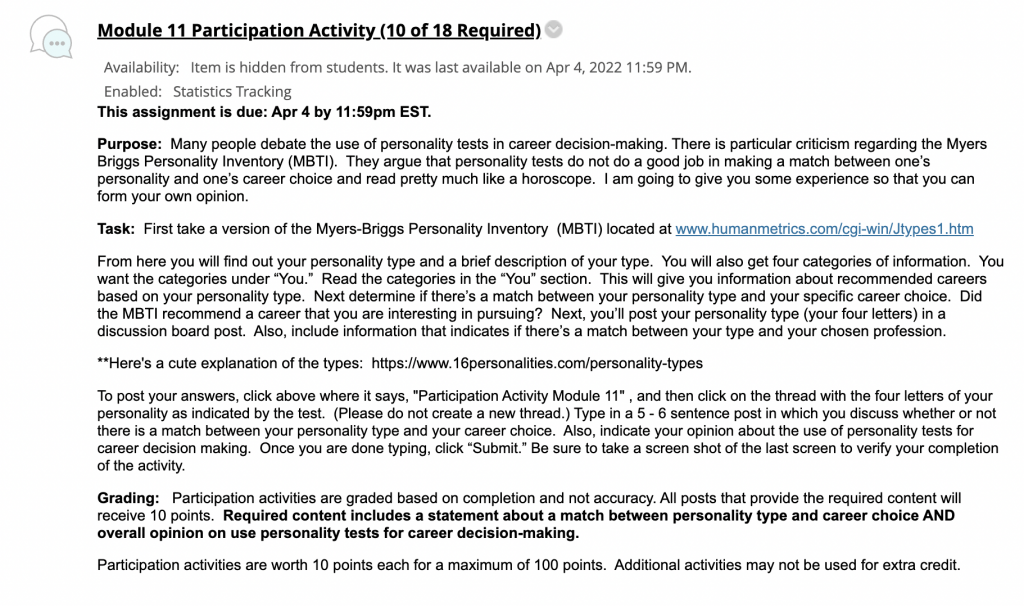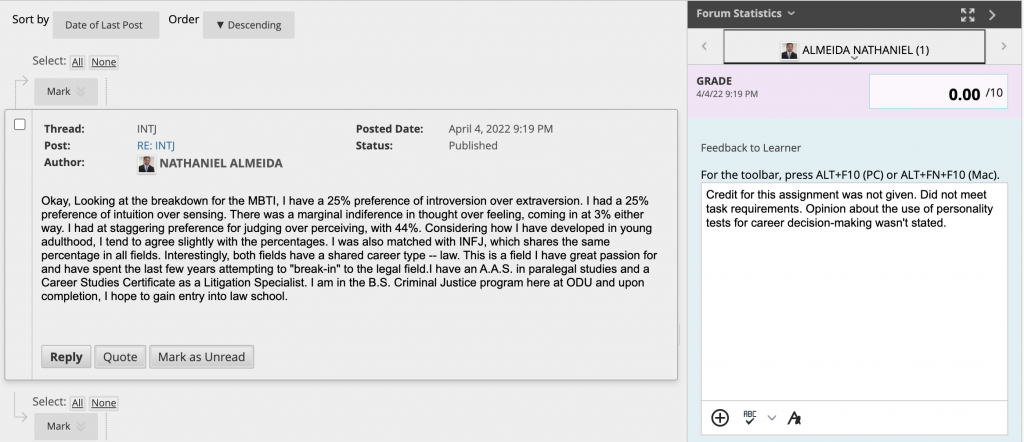- Participation activities: throughout the course, one of the teaching activities I was required to complete was to grade the students’ participation activities. The Lifespan development course consisted of fourteen participation activities for each module and four exam reviews. This activity consisted of grading the students’ assignments based on the rubric provided for each module. These assignments were graded on a pass-fail basis. Ten participation activities were required to be completed out of eighteen. Ten points were given for each assignment for a total of one hundred points.
- Extra credit: another teaching activity that I completed as a UTA was grading extra credit assignments. Fourteen extra credit opportunities were given throughout the semester. Out of the Fourteen extra credit opportunities, students were given the chance to receive credit for ten of them. These assignments, much like the participation activities, were graded on a pass-fail basis. Each extra credit assignment was worth three points. Therefore, students were allowed a max of thirty points of extra credit.
- Feedback: grading the extra credit and participation activities also required I give feedback to students if they did not satisfy the assignment tasks. When necessary, a brief description was given as to why the student did not receive credit for the respective assignment.
Artifact
The artifact that I provided is a written assignment. More specifically, this artifact is a participation activity assignment for module 11. This activity would be considered a structured assignment. The topic that the students were to write on for this assignment was the use of personality tests concerning career decision-making. The task objectives included taking a version of the Myers-Briggs Personality Inventory followed by an evaluation of the recommended careers given based on one’s personality type. This assignment also required a statement about the student’s opinion regarding the use of personality tests for career decision-making. For this assignment, my role was to score/grade it and provide feedback if necessary.
This participation activity connects to my teaching philosophy in several ways. For instance, this participation activity required the students to take a personality test and report their results as it relates to their career choice. For this assignment to be completed, the students had to apply the course material to themselves. This allowed for better facilitation of learning considering applying the material to one self promotes learning and allows the information to be more effectively stored in one’s long-term memory. Another way this activity connects to my teaching philosophy is through the form of feedback. Part of my teaching philosophy includes providing detailed feedback to students as a way to provide an opportunity for them to learn from their mistakes in the hopes that they will improve academically throughout their college careers. This also emphasizes the skill of critical thinking as the feedback given allows the student to evaluate their performance and provides a foundation for them to improve.
I learned a great deal from grading this participation activity. For example, throughout the process of grading this assignment, I learned that the students were highly opinionated when it comes to something as intimate and personal as personality. This reinforced my belief that applying the information to oneself enhances the learning process. Getting the students actively engaged with the material in a way that made them turn the information inward promoted critical thinking skills. One characteristic that I developed as a result of grading this activity was I began to feel as if I knew the students in a way. Due to reading their personality results and corresponding career choices. This type of assignment could enhance the learning experience by giving the instructor insight into the students’ future career choices. In theory, the instructor could use this information and incorporate aspects of the students’ career goals into future module assignments. Thus, promoting the facilitation of applying the course material to one’s daily life. If I had to do this activity again, I believe I would have done a few things differently. For example, I would have given feedback to every student regardless if they received credit or not. If the student received credit, instead of leaving the feedback blank, I would reinforce any positive learning strategies that they implemented while completing the assignment. This concludes my reflection on how the teaching activities I performed reflect my teaching philosophy.

